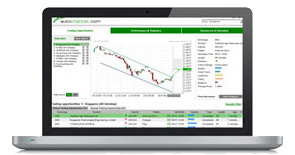
A day trading strategy must include entry and exit signals; in other words, when to get into a position and when to get out of it (request a demo on the right to get free access to an award winning signals software that will visually show you where to buy and sell).
The entry signal has to be specific and must include the conditions that must be met in order to enter a trade. For example, when Condition A, B, C, … , etc. are met, enter the trade. These conditions must be as objective as possible. For example, specific conditions can be “buy or sell when the stock breaks the highest price of the previous 30 minutes or the lowest price of the prior 60 minutes respectively” or “buy when the price of a currency goes 15 pips above its 19-period moving average.” These are quantifiable events. They can be measured.
The condition, “buy when the price of the stock is trending up,” is not specific enough. It does not specify what “trending up” means. How can you trade based on a signal that you don’t know exactly what it means? Generalities like these are what cause traders to lose money.
After the system being used generates an entry signal and a position is taken, the exit conditions also have to be known; in other words, when the position will be closed. The closing of the position can either be when the desired profit is realized or when the maximum allowable loss is reached (in the section on placing stops, I discuss this in greater detail).
The strategy has to define exactly when the trader will realize his profit and look for another trade. If the profit condition is met, the day trader MUST exit. He cannot use discretion and try to guess if the profit will be more or less than usual – he MUST follow his own rules!!! To minimize the probability of getting out of a winning position too early, the strategy can use multiple exit signals for different parts of the whole position; for example, instead of selling the 300,000 Euro-U.S. Dollar position all at once, the trader can sell one lot (100,000) at a time based on specific conditions as the trade progresses.
Even though it would be great if every trade was successful, the trader has to be prepared for a reality of trading: losing. Consequently, the day trader must know [based on his strategy] exactly when to exit a trade if it goes against him.
A complete system must pinpoint where on the chart the trader must take his loss. This could be when the price of a stock or currency breaks a technical support or resistance level on the chart (the high or low price during a period of time – the last day, the last 10 minutes, the last hour, etc.), when an indicator reaches an extreme value, or a combination of conditions. Again, these signals have to be quantifiable and not subjective (“when I see the price starting to stall” is not a good enough signal).
BEFORE the trader even enters a trade, he must know where the exit point will be. This is essential to build trading discipline and to make sure that the trader will reduce his overall risk. This is discussed in more detail in the stop loss section.
If a trader gets a buy signal based on his strategy, but the logical place to limit his loss on the chart represents a loss that is too big for his account, he should not enter the trade. Thus, he must make sure that every trade that he takes is within the maximum allowable loss according to his system. Controlling the amount of risk that he takes is of paramount importance to his trading survival. This is discussed in greater detail in the trading and risk management section.
How a trader manages his position after entering a trade is explained in the smart money management section.
